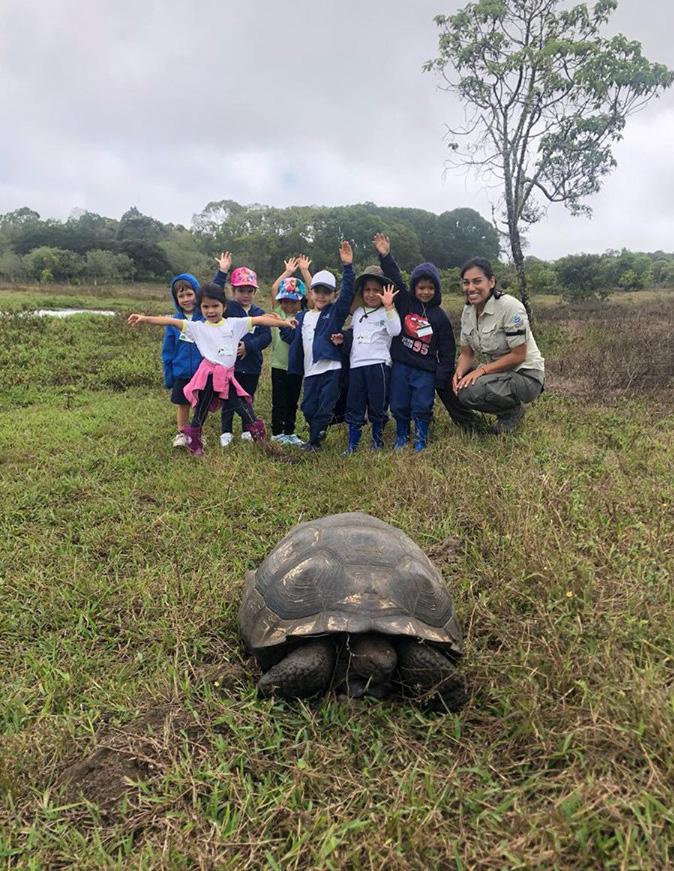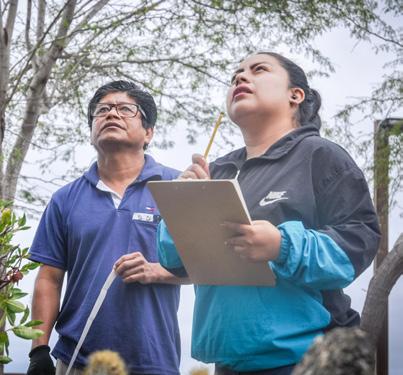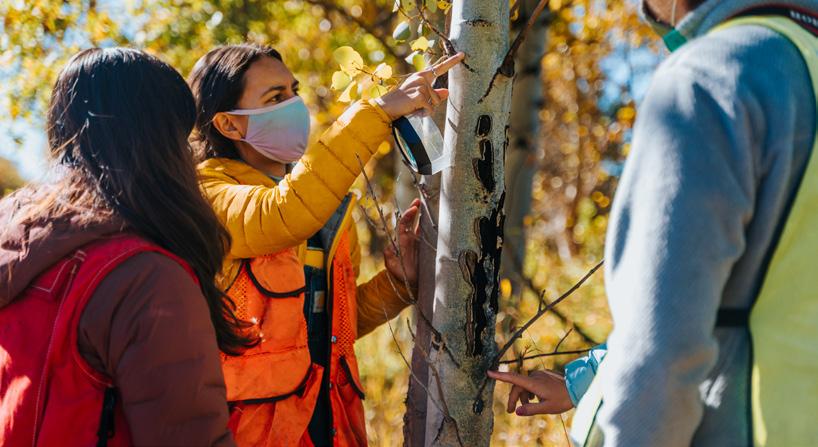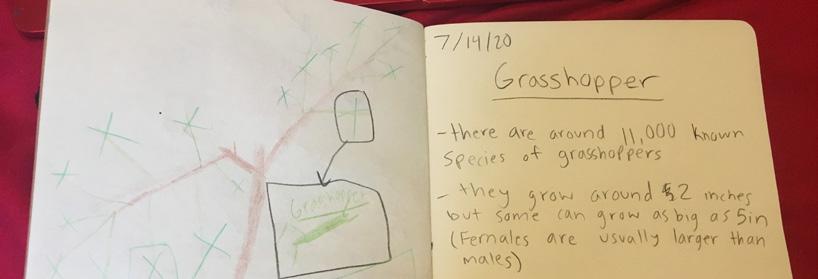
5 minute read
Place-Based Education for All
How Galapagos has Trained All of its Teachers in Education for Sustainability in the Last Five Years
Richard Knab met Leslie Cook in February of 2020, right before the pandemic hit the United States. Leslie, our Senior Director of Educator Development, was leading a workshop called Place-based Education Introduction in Hartford, Vermont. Richard, Director of Strategic Partnerships at Galapagos Conservancy, was a participant.
Advertisement
While he connected with TSS recently, Richard is no stranger to place-based education. Twenty years ago, Richard was living in Honduras with his family, working at Zamorano University, a unique center of learning known for its emphasis on learning-by-doing, when he was asked to form part of a team to revamp a traditional K-8 school located on campus. Richard and his colleagues saw an opportunity to break with convention and connect learning to place. Within several years, the Alison Bixby Stone School became a vibrant learning community that extended the classroom to include Zamorano’s agricultural fields, forests, laboratories and surrounding communities, instilling children with a deep love of learning. The experience stayed with him as he moved back to the U.S. and began working at the Galapagos Conservancy, a Fairfax, VA-based nonprofit whose mission is to “protect the unique biodiversity and ecosystems of Galapagos by supporting research and management, informing public policy, and building a sustainable society.” (Galapagos Conservancy) In Galapagos, 350 preK-12 teachers work in 20 schools spread across four islands, instructing 7500 students. Historically, these teachers have had very little access to professional development, resulting in a heavy reliance on textbooks and rote learning, despite the Islands’ amazing natural setting. Since the 1990s, the Fundacion Scalesia has been dedicated to strengthening education in Galapagos. In 2014, Scalesia partnered with Galapagos Conservancy and Ecuador’s Ministry of Education to “identify the most effective strategies for launching an archipelago-wide education improvement program” (Scalesia Foundation). This partnership, coordinated by Richard, identified the need for evidence-based, studentcentered pedagogy and began developing the Education for Sustainability Program, designed to transform education in the Galapagos through intensive teacher professional development.
When designing the program, Richard thought back to his experience in Honduras and the lessons of connecting education to place. He centered the program around Education for Sustainability (a concept very similar to place-based education), believing that an interdisciplinary approach to teaching, connected to place, would lead to better education outcomes and ultimately prepare young people to make a positive difference in their communities.
Since April 2016, 100% of teachers in Galapagos have gathered twice a year for weeklong immersive training, which is complemented by classroom observation and feedback (coaching) and professional learning circles throughout the year. Now in its fifth year, the program has developed a team of 40 like-minded training facilitators from Ecuador, the U.S. and various Latin American countries, all of whom speak fluent Spanish. But who trains the trainers? That’s where TSS comes in. After meeting Leslie in Vermont, Richard was excited to “involve a significant number of our trainers in a TSS course, to help strengthen and align our thinking related to place-based education”.
In a non-pandemic year, it would be costly and unrealistic for the Galapagos Conservancy to send trainers from across the U.S. and Latin America to Jackson, WY for a Teacher Learning Center workshop. But in a COVID-19 landscape, the course was offered virtually, allowing 14 Galapagos Conservancy training facilitators to join 30 other educators for the Introduction to Place-based Education virtual course. “I think it enhanced our course to have so many different perspectives,” said Leslie. Educators from Ecuador joined teachers from rural, suburban and urban communities across the U.S., university professors, informal educators and others on Zoom to discuss best practices in place-based education. “After the workshop, I think we have a better shared vocabulary, we are looking at our conceptual approach a little differently, and our trainers are rejuvenated and looking forward to the future,” said Richard.

Photo Courtesy of the Galapagos Conservancy
María José Reichenbach was one of the trainers from the Galapagos Conservancy to attend the virtual TSS workshop. She is part of the English team at the Conservancy, supporting English teachers in the Galapagos, where English is part of the curriculum beginning in elementary school. “I loved the course, it was one of the highlights of my summer,” she said. “I used to have this idea that place-based education was only about interacting with nature, but in the end I think it really connects with Education for Sustainability because it’s understanding your place from several different perspectives: social, environmental and economic.”
As part of the virtual workshop this summer, teams of educators were asked to design a place-based lesson, unit or project to implement in their communities. María José and two other facilitators for the ESG team, Susan Huss-Lederman and Leanne Kirk, decided on a community garden program, where each school in the Galapagos will create a garden through which, they as facilitators, can model how students can learn about sustainability with an interdisciplinary focus and develop a specific product to give back to their community. “The goal is to create a space where students can take care of nature and understand how they can have a positive impact on it,” said María José. “We really need these tools...so that students can see why it’s necessary to connect learning to the place that they live in.”
Galapagos is a truly unique place in its biodiversity and scientific importance. Teachers on the islands have been able to transform their teaching practices by learning through an Education for Sustainability lense in order to encourage students to “understand and embrace their pivotal role in shaping a sustainable society” (Galapagos Conservancy). A teacher from Isabela Island and her students made reusable shopping bags out of t-shirts as an alternative to plastic bags, which are banned in the Galapagos. Another teacher from Santa Cruz Island had their students write signs in English asking visitors to treat the island with respect and care.
The Ministry of Education in Ecuador has taken notice of the success of Education for Sustainability in Galapagos. “The Ministry saw our approach in Galapagos as something they want to do nationally,” explained Richard. “In a new, Covid-19 related Ministry initiative, all teachers are being asked to think about place and connecting learning to place.”
For teachers in Galapagos, many of them originally from the mainland, developing a connection to the islands is a foundational first step in making connections to local issues, and connecting those issues to learning objectives in the national curriculum. Galapagos teachers have remained enthusiastic about the program as it continues to grow. In the next year, 40 Galapagos teachers trained by the program as instructional coaches will complement the efforts of program staff. Looking further ahead, the Fundacion Scalesia will assume greater leadership in this work, with the goal, in Richard’s words, “of becoming the TSS of Galapagos.”

Photo courtesy of the Galapagos Conservancy






